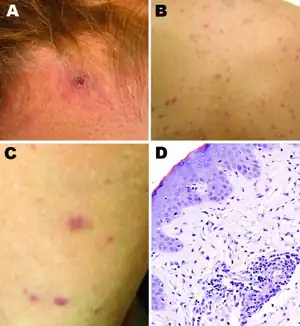American tick bite fever
| American tick bite fever | |
|---|---|
| Other names: Rickettsia parkeri infection | |
 | |
| Suspected and confirmed Rickettsia parkeri rickettsiosis- A) Eschar at nape of neck at site of recent tick bite b,c)) papulovesicular rash involving the back and lower extremities d) histopathologic appearance of a papule biopsy specimen, showing perivascular mononuclear inflammatory cell infiltrates | |
| Specialty | Infectious disease |
| American tick bite fever | |
|---|---|
| Scientific classification | |
| Domain: | Bacteria |
| Phylum: | Pseudomonadota |
| Class: | Alphaproteobacteria |
| Order: | Rickettsiales |
| Family: | Rickettsiaceae |
| Genus: | Rickettsia |
| Species group: | Spotted fever group |
| Species: | R. parkeri |
| Binomial name | |
| Rickettsia parkeri Lackman et al. 1965 | |
American tick bite fever (also known as "Rickettsia parkeri infection") is a spotted fever disease caused by the tick-borne bacterium Rickettsia parkeri. Symptoms may include a fever, red spots on the skin throughout the body, and an eschar at the site of the tick-bite.[1]
See also
References
- ↑ Rapini, Ronald P.; Bolognia, Jean L.; Jorizzo, Joseph L. (2007). Dermatology: 2-Volume Set. St. Louis: Mosby. p. 1130. ISBN 978-1-4160-2999-1.
- "Rickettsia parkeri". NCBI Taxonomy Browser. 35792. Archived from the original on 2019-09-15. Retrieved 2021-05-28.
External links
| Classification |
|---|
This article is issued from Wmcloud. The text is licensed under Creative Commons - Attribution - Sharealike. Additional terms may apply for the media files.